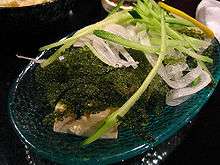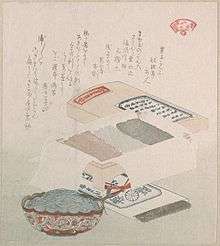Edible seaweed

Edible seaweed are algae that can be eaten and used in the preparation of food. They typically contain high amounts of fiber and are a complete protein.[1] They may belong to one of several groups of multicellular algae: the red algae, green algae, and brown algae.
Seaweeds are also harvested or cultivated for the extraction of alginate, agar and carrageenan, gelatinous substances collectively known as hydrocolloids or phycocolloids. Hydrocolloids have attained commercial significance, especially in food production as food additives.[2] The food industry exploits the gelling, water-retention, emulsifying and other physical properties of these hydrocolloids.
Most edible seaweeds are marine algae whereas most freshwater algae are toxic. Some marine algae contain acids that irritate the digestion canal, while some others can have a laxative and electrolyte-balancing effect.[3]
The dish often served in western Chinese restaurants as 'Crispy Seaweed' is not seaweed but cabbage that has been dried and then fried.[4]
Distribution
Seaweeds are used extensively as food in coastal cuisines around the world. Seaweed has been a part of diets in China, Japan, and Korea since prehistoric times.[5] Seaweed is also consumed in many traditional European societies, in Iceland and western Norway, the Atlantic coast of France, northern and western Ireland, Wales and some coastal parts of South West England,[6] as well as Nova Scotia and Newfoundland. The Māori people of New Zealand traditionally used a few species of red and green seaweed.[7]
Nutrition and uses
Seaweed contains high levels of iodine relative to other foods.[8] In the Philippines, Tiwi, Albay residents discovered a new pancit or noodles made from seaweed, which can be cooked into pancit canton, pancit luglug, spaghetti or carbonara and is claimed to have health benefits such as being rich in calcium, magnesium and iodine.[9]
Polysaccharides in seaweed may be metabolized in humans through the action of bacterial gut enzymes. Such enzymes are frequently produced in Japanese population due to their consumption of seaweeds.[10]
In some parts of Asia, nori 海苔 (in Japan), zicai 紫菜 (in China), and gim 김 (in Korea), sheets of the dried red alga Porphyra are used in soups or to wrap sushi or onigiri. Chondrus crispus (commonly known as Irish moss) is another red alga used in producing various food additives, along with Kappaphycus and various gigartinoid seaweeds.
Japanese cuisine has seven types of seaweed identified by name, and thus the term for seaweed in Japanese is used primarily in scientific applications, and not in reference to food.
 Sea grapes (Caulerpa lentillifera) are cultivated in ponds in the Philippines[11]
Sea grapes (Caulerpa lentillifera) are cultivated in ponds in the Philippines[11] Sea grapes are usually eaten raw with vinegar, as a snack or in a salad[12]
Sea grapes are usually eaten raw with vinegar, as a snack or in a salad[12]

 Cakes and Food Made of Seaweed by Kubo Shunman, 19th century
Cakes and Food Made of Seaweed by Kubo Shunman, 19th century
Common edible seaweeds
Common edible seaweeds[13] include:
Red algae (Rhodophyta)
Green algae
|
Brown algae (Phaeophyceae)Kelp (Laminariales)
Fucales
Ectocarpales
|
See also
References
- ↑ K.H. Wong, Peter C.K. Cheung (2000). "Nutritional evaluation of some subtropical red and green seaweeds: Part I — proximate composition, amino acid profiles and some physico-chemical properties". Food Chemistry. 71 (4): 475–482. doi:10.1016/S0308-8146(00)00175-8.
- ↑ Round F.E. 1962 The Biology of the Algae. Edward Arnold Ltd.
- ↑ Wiseman, John SAS Survival Handbook
- ↑ Hom, Ken (2012). "Crisp Seeweed". Good Food Channel. UK TV.CO.UK. Retrieved 2014. Check date values in:
|access-date=(help) - ↑ "Seaweed as Human Food". Michael Guiry's Seaweed Site. Retrieved 2011-11-11.
- ↑ "Spotlight presenters in a lather over laver". BBC. 2005-05-25. Retrieved 2011-11-11.
- ↑ "Kai Recipe's used by Kawhia Maori & Early Pioneers". Kawhia.maori.nz. Retrieved 2011-11-11.
- ↑ "Micronutrient Information Center: Iodine". Oregon State University: Linus Pauling Institute. Retrieved 2011-11-11.
- ↑ "Albay folk promote seaweed 'pansit'". ABS-CBN Regional Network Group. 2008-04-08. Retrieved 2009-08-04.
- ↑ Hehemann, Jan-Hendrik; Correc, Gaëlle; Barbeyron, Tristan; Helbert, William; Czjzek, Mirjam; Michel, Gurvan (8 April 2010). "Transfer of carbohydrate-active enzymes from marine bacteria to Japanese gut microbiota". Nature. 464 (7290): 908–912. doi:10.1038/nature08937. PMID 20376150.
- ↑ Dawes, Clinton J. (1998). Marine botany. New York: John Wiley. ISBN 0-471-19208-2.
- ↑ Lato, the strange sea salad The trade of the Caulerpa lentillifera in Coron, Philippines
- ↑ Harrison, M. (2008). "Edible Seaweeds around the British Isles". Wild Food School. Retrieved 2011-11-11.
External links
| Wikimedia Commons has media related to Edible seaweed. |
- Seaweeds used as human food an FAO report
